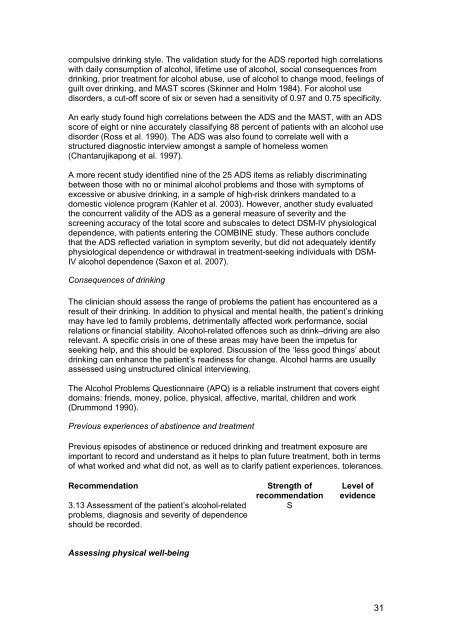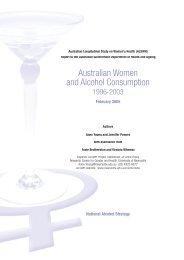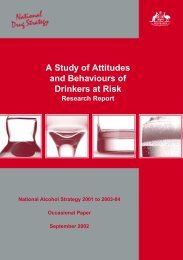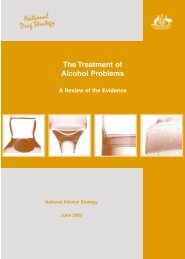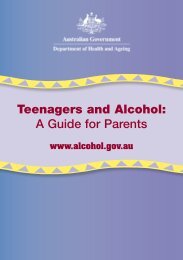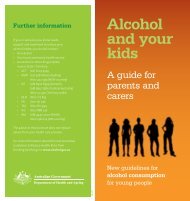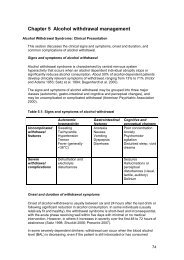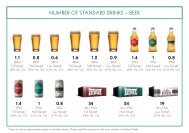Chapter 3 Screening, assessment and treatment planning - Alcohol
Chapter 3 Screening, assessment and treatment planning - Alcohol
Chapter 3 Screening, assessment and treatment planning - Alcohol
You also want an ePaper? Increase the reach of your titles
YUMPU automatically turns print PDFs into web optimized ePapers that Google loves.
compulsive drinking style. The validation study for the ADS reported high correlationswith daily consumption of alcohol, lifetime use of alcohol, social consequences fromdrinking, prior <strong>treatment</strong> for alcohol abuse, use of alcohol to change mood, feelings ofguilt over drinking, <strong>and</strong> MAST scores (Skinner <strong>and</strong> Holm 1984). For alcohol usedisorders, a cut-off score of six or seven had a sensitivity of 0.97 <strong>and</strong> 0.75 specificity.An early study found high correlations between the ADS <strong>and</strong> the MAST, with an ADSscore of eight or nine accurately classifying 88 percent of patients with an alcohol usedisorder (Ross et al. 1990). The ADS was also found to correlate well with astructured diagnostic interview amongst a sample of homeless women(Chantarujikapong et al. 1997).A more recent study identified nine of the 25 ADS items as reliably discriminatingbetween those with no or minimal alcohol problems <strong>and</strong> those with symptoms ofexcessive or abusive drinking, in a sample of high-risk drinkers m<strong>and</strong>ated to adomestic violence program (Kahler et al. 2003). However, another study evaluatedthe concurrent validity of the ADS as a general measure of severity <strong>and</strong> thescreening accuracy of the total score <strong>and</strong> subscales to detect DSM-IV physiologicaldependence, with patients entering the COMBINE study. These authors concludethat the ADS reflected variation in symptom severity, but did not adequately identifyphysiological dependence or withdrawal in <strong>treatment</strong>-seeking individuals with DSM-IV alcohol dependence (Saxon et al. 2007).Consequences of drinkingThe clinician should assess the range of problems the patient has encountered as aresult of their drinking. In addition to physical <strong>and</strong> mental health, the patient’s drinkingmay have led to family problems, detrimentally affected work performance, socialrelations or financial stability. <strong>Alcohol</strong>-related offences such as drink–driving are alsorelevant. A specific crisis in one of these areas may have been the impetus forseeking help, <strong>and</strong> this should be explored. Discussion of the ‘less good things’ aboutdrinking can enhance the patient’s readiness for change. <strong>Alcohol</strong> harms are usuallyassessed using unstructured clinical interviewing.The <strong>Alcohol</strong> Problems Questionnaire (APQ) is a reliable instrument that covers eightdomains: friends, money, police, physical, affective, marital, children <strong>and</strong> work(Drummond 1990).Previous experiences of abstinence <strong>and</strong> <strong>treatment</strong>Previous episodes of abstinence or reduced drinking <strong>and</strong> <strong>treatment</strong> exposure areimportant to record <strong>and</strong> underst<strong>and</strong> as it helps to plan future <strong>treatment</strong>, both in termsof what worked <strong>and</strong> what did not, as well as to clarify patient experiences, tolerances.Recommendation3.13 Assessment of the patient’s alcohol-relatedproblems, diagnosis <strong>and</strong> severity of dependenceshould be recorded.Strength ofrecommendationSLevel ofevidenceAssessing physical well-being31


